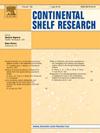温带日本沿海夏季游离虫黄藻丰度的变化(日本高岛)
IF 2.2
3区 地球科学
Q2 OCEANOGRAPHY
引用次数: 0
摘要
游离或外源虫黄藻对珊瑚的生存起着至关重要的作用;然而,它们的生态动态在很大程度上仍未被探索。本研究采用定量聚合酶链式反应(qPCR)技术,对夏季至初秋期间日本高岛温带沿海海域海水中游离虫黄藻(A ~ F枝)的丰度进行了跟踪研究。此外,我们还研究了温度、光照条件(光合光子通量密度[PPFD])、溶解无机氮(DIN)和珊瑚健康对虫黄藻丰度的影响。我们的研究结果显示,从夏末到初秋,自由生活的虫黄藻的丰度增加,无论进化支如何。使用通用引物扩增的核糖体RNA (rRNA)基因拷贝数与珊瑚健康评分之间存在显著的负相关。相反,rRNA基因拷贝数与海水温度呈正相关。PPFD与DIN的关系与rRNA基因拷贝数无显著相关。值得注意的是,使用Clade C引物扩增的rRNA基因拷贝数最丰富,与海水温度呈显著正相关,而与珊瑚健康评分呈负相关。海水温度上升和宿主珊瑚释放虫黄藻细胞促进了海水中自由生活的虫黄藻(特别是C枝)数量的增加,而后者可能是主要因素。据我们所知,这是第一个监测海水中自由生活的虫黄藻丰度的时间变化的研究。本文章由计算机程序翻译,如有差异,请以英文原文为准。
Changes in free-living zooxanthellae abundance during summer in a temperate Japanese coastal sea (Takashima, Japan)
Free-living or exogenous zooxanthellae play a crucial role in coral survival; however, their ecological dynamics remain largely unexplored. This study focused on tracking the abundance of free-living zooxanthellae (Clades A to F) in seawater around the temperate coastal sea (Takashima, Japan) from summer to early autumn using quantitative polymerase chain reaction (qPCR). In addition, we examined the influence of temperature, light conditions (photosynthetic photon flux density [PPFD]), dissolved inorganic nitrogen (DIN), and coral health on the abundance of zooxanthellae. Our findings revealed an increase in the abundance of free-living zooxanthellae from late summer to early autumn, irrespective of clade. A significant negative correlation was observed between the ribosomal RNA (rRNA) gene copy number, amplified using a universal primer, and coral health scores. Conversely, there was a positive correlation between the rRNA gene copy number and seawater temperature. The relationship between PPFD and DIN was not significantly correlated with rRNA gene copy number. Notably, the rRNA gene copy number, amplified using the Clade C primer, was the most abundant and exhibited a significant positive correlation with seawater temperature, whereas it was negatively correlated with coral health scores. The increase in the abundance of free-living zooxanthellae, particularly Clade C, in seawater was facilitated by rising seawater temperatures and the release of zooxanthellae cells from host corals, with the latter likely being the predominant factor. To our knowledge, this is the first study to monitor temporal changes in the abundance of free-living zooxanthellae in seawater.
求助全文
通过发布文献求助,成功后即可免费获取论文全文。
去求助
来源期刊

Continental Shelf Research
地学-海洋学
CiteScore
4.30
自引率
4.30%
发文量
136
审稿时长
6.1 months
期刊介绍:
Continental Shelf Research publishes articles dealing with the biological, chemical, geological and physical oceanography of the shallow marine environment, from coastal and estuarine waters out to the shelf break. The continental shelf is a critical environment within the land-ocean continuum, and many processes, functions and problems in the continental shelf are driven by terrestrial inputs transported through the rivers and estuaries to the coastal and continental shelf areas. Manuscripts that deal with these topics must make a clear link to the continental shelf. Examples of research areas include:
Physical sedimentology and geomorphology
Geochemistry of the coastal ocean (inorganic and organic)
Marine environment and anthropogenic effects
Interaction of physical dynamics with natural and manmade shoreline features
Benthic, phytoplankton and zooplankton ecology
Coastal water and sediment quality, and ecosystem health
Benthic-pelagic coupling (physical and biogeochemical)
Interactions between physical dynamics (waves, currents, mixing, etc.) and biogeochemical cycles
Estuarine, coastal and shelf sea modelling and process studies.
 求助内容:
求助内容: 应助结果提醒方式:
应助结果提醒方式:


